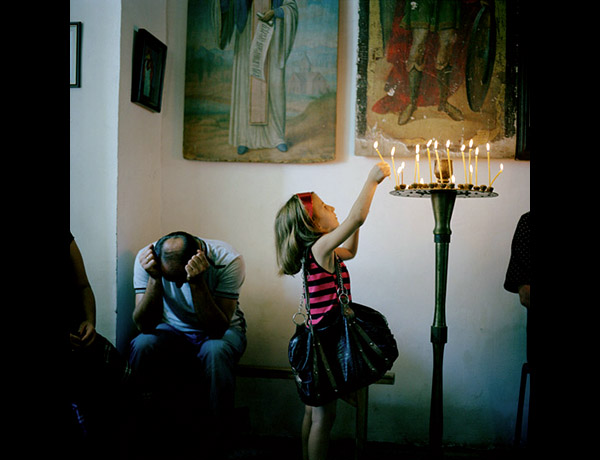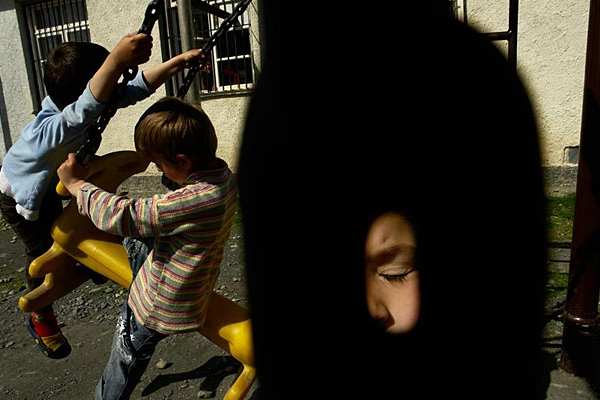 |
| Gali, Abkhazia’s frontier with Georgia 2010 |
(vervephoto.wordpress.com) Ivor Prickett (b.1983, Ireland) completed a degree in Documentary Photography at the University of Wales, Newport. With a particular interest in post war situations Ivor has worked on a number projects throughout the Balkans and more in recently in the Caucasus. He is currently based in the Middle East from where he works for leading publications. Ivor’s work has been recognized through a number of major photography awards including The Ian Parry Scholarship, the BJP/Nikon Endframe Award and the National Portrait Gallery Photography Prize Godfrey Argent Award. His photographs have been published in The Sunday Times magazine, The Guardian Weekend magazine, Geo Germany, Stern Geographical, Fader, Exit and among other publications.
About the Photograph:
“This picture is from my project Gali: Abkhazia’s frontier with Georgia. It takes a look at daily life for the Mingrelian Georgians who still live in the breakaway republic. I made two trips there over the past year and this photo was from my second in August and September during a visit to the only functioning church left in Gali, the province where almost all of the 40,000 Georgian returnees are concentrated in Abkhazia. It is a tiny, very sparsely decorated church set just off the main road that leads into Abkhazia from the border with Georgia. The day we went was a very important day in the orthodox calendar and people had come from all over the region to attend the service. Although the scenes inside were very beautiful, taking picture was especially hard because there was little space to maneuver and limited available light. When I saw the young girl reach up to light the candle I knew it was a nice scene and quickly got myself in position to take the picture. I managed to shoot maybe four frames and afterword’s I was relived to see that I had guessed the right exposure! I think this could easily have been a rather clichéd image but for me the man with his head in his hands gives it a more poignant and balanced feel.”
+++
 |
| Chechen Refugee Settlement. Pankisi Gorge, Georgia 2008 |
Daro Sulakauri (b.1985, Georgia) obtained a degree from the Department of Cinematography at the Tbilisi State University. Soon after, she moved to New York to study photojournalism at ICP. Before graduating in 2006 she was awarded the John and Mary Phillips Scholarship as well as recognized by the ICP Director’s Fund. Upon finishing, she returned to the Pankisi Gorge in her native Caucasus nation of Georgia and continued Photojournalism. She won second place in the Magnum Foundation’s Young Photographer Caucasus award in 2009 and the SCI (Civil Society Institute) award for the Best of Photojournalism. She was also featured in the American Photography 25 book: Social Documentary’s best of 2008, and received honorable mentions in the PX3 and B&W Awards.
About the Photograph:
“This photo is from series “Terror Incognita” a personal project I started in Pankisi Gorge, a region in Republic of Georgia. The Story documents one of the Chechen conflict’s hidden narratives in an outpost of refugees who crossed to Georgia from Chechnya and have remained in relative isolation ever since. Chechens have a reputation for rugged individualism, even among the peoples of the Caucasus who – by any standards – are accustomed to rugged conditions and nurture a fierce sense of national pride and independence in light the imperialist tendencies of surrounding nations. These people live an ordinary life today, although they are largely destroyed psychologically. Without a clear future and struggling with the past, they still have hope to return home one day. (more…)
+++
 |
| Tbilisi, Georgia 2010 |
About the Photograph:
“’My country has a very rich history and culture, but nowadays there is no real development. Officials do everything to make things look good on the outside, but inside everything is rotten, the economy and the lives of people are crumbling just like our buildings.’ These are the words of Miranda, a 25 years old Georgian girl who tries to earn some money by offering guided tours to tourists in Tbilisi. I met her after I came back from a research trip to a farmers village, where we would later shoot a documentary for an NGO. My plane to Zürich was cancelled because of the vulcano eruption in Iceland and I was stuck in Tbilisi for several days. I hired Miranda as a translator and asked her to introduce me to everyday life in the Georgia – or at least to what it means to live there from her point of view. This is one image out of a photo essay about the depleted ex Soviet country. I took it when we entered a church where a mass was taking place. Killing time, hoping and praying that things will become better seems to be the only perspective for many Georgians.”
+++
 |
| Fleeing the War in Georgia, 2008 |
Lars Lindqvist (b. 1981, Sweden) is a staff photographer at Sweden’s largest daily newspaper Dagens Nyheter. He took up photography in high school.and after graduation left to travel in Asia, and later the Middle East, Africa and Latin America. After nearly four years of he realized that it was possible to live on his ever-growing hobby, photography, and in 2006 he decided to try it out. Since then he has received a number of awards, including a World Press Photo, Picture of the Year International, a Swedish picture of the year award, and the PGB Photo Award. In 2008 he was one of the photographers selected to participate in the first Nordic Masterclass. Lars is a member of the Swedish photo agency Kontinent.
About the Photograph:
“I spent three weeks in Georgia covering the war with the Russians. It was the first war I ever covered and this image was made on one of my very first days in the country. The image is a part of a bigger story about what I saw and experienced in the war. It’s of a woman fleeing the war, leaving her man behind. This situation just knocked me to the floor. You know when you walk the streets taking pictures, looking for something, but you dont excatlly know what. All of a sudden something happens in front of you and you know you got your shot. This was one of these moments. The image just appeard infront of me and I knew this would be an importent part of my story. I didnt talk to them but when I see this image my imagination started to flying. Who is she? What is she thinking? I guess at this point of the war anything could have happened and I wonder what she thinks of her future in this particular situation.”
+++
 |
| Tbilisi, Georgia, August 2008 |
Jared Moossy (b.1980, USA) is a documentary photographer based in Dallas, Texas. He is represented by Redux Pictures in New York and is a member of Razon. Jared graduated from Parsons School of Design in 2008. His work has mostly been focused on the changing country of Afghanistan and the heightened tension of Mexico’s internal war on Drugs. Jared attended the Eddie Adams Workshop in 2008 and won the PDN Photo Annual and Marty Forcher fellowship fund the same year. He was awarded a place in PDN 30′s emerging photographers in 2009. His work has been published in Newsweek, Time, The Wall Street Journal, Stern, Magazine, Conde Nast Traveler and Die Ziet.
About the Photograph:
“This photograph of a Georgian soldier released during a prisoner exchange with the South Ossetians arrived at Ghudushauri hospital and was reunited with his loved ones. It was taken amidst a point of uncertainly shortly after the conflict started, and the release of the prisoners during that conflict gave the Georgians a sense of hope in a time when most Georgians thought the conflict would grow. I think this photograph conveys a struggle separated by two clearly defined sides and shows the viewer a look of desperation and apprehension in the eyes of this Georgian soldier.”
+++
 |
| Young Russian tourists visit an Orthodox monastery. Abkhazia, 2007 |
Justyna Mielnikiewicz was born in Poland in 1973 and has been working as a professional photographer for seven years. She graduated from Jagiellonian University in Krakow with a Masters in New Media and Culture Management. After finishing university she began to work as photojournalist with the daily newspaper Gazeta Wyborcza. In 2001 she became a freelance photographer and moved to Tbilisi, Georgia to work on a long term project on the South Caucasus. The project was awarded an honorable mention for the 2003 Dorothea Lange/ R. Taylor Prize and received a grant from the European Culture Foundation. Her photographs have appeared in: Newsweek, Paris Match, The New York Times, Frankfurter Allgemeine Zeitung, among others and were screened at Arles in 2005. Her work is distributed by Cosmos Agency , World Picture News and Eve Photographers.
About the Photograph:
Every summer Russian tourists arrive by the thousands at a Black Sea resort area they regard as their own. They come with urges shared by tourists the world over, for sun and drink and days lounging on the shore. Their destination is officially Georgia. But in their minds it is not Georgia at all. It is Abkhazia, one of the thorniest issues dividing Russia and Western-supported Georgia in the volatile Caucasus. It is one of four small regions in the southwestern reaches of the former Soviet Union whose status, 15 years on, remains unresolved. The others — South Ossetia, Nagorno-Karabakh and Transnistria — are in Georgia, Azerbaijan and Moldova, respectively. Photographers Journal: Abkhazia.











No comments:
Post a Comment